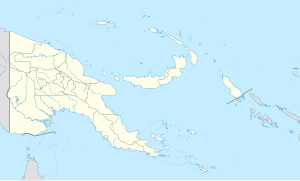Mount Hagen
|
Mount Hagen The Heart of the Highlands |
|
|---|---|
| Town | |

Mt Hagen Cultural Show, one of the largest annual cultural events in Papua New Guinea
|
|
 Satellite view |
|
| Location in Papua New Guinea | |
| Coordinates: 5°51′36″S 144°14′24″E / 5.86000°S 144.24000°ECoordinates: 5°51′36″S 144°14′24″E / 5.86000°S 144.24000°E | |
| Country |
|
| Province | Western Highlands Province |
| District | Mount Hagen District |
| Established | 1934 |
| Elevation | 1,677 m (5,502 ft) |
| Population (2013) | |
| • Total | 46,256 |
| Time zone | AEST (UTC+10) |
| Main languages | Melpa, Tok Pisin, English |
| Climate | Cfb |
Mount Hagen is the third largest city in Papua New Guinea, with a population of 46,250. It is the capital of the Western Highlands Province and is located in the large fertile Wahgi Valley in central mainland Papua New Guinea, at an elevation of 1,677 m (5,502 ft).
The Highlands Highway is the main arterial route to connect Mount Hagen with the coastal cities of Lae and Madang.
The city is named after the old eroded volcano Mount Hagen, located about 24 kilometres (15 mi) to the north-west. The volcano was named after the German colonial officer Curt von Hagen (1859-1897).
In 1933 Mick Leahy, brother Dan Leahy, and government officer Jim Taylor conducted an aerial reconnaissance of the highlands and discovered the huge and heavily populated Wahgi Valley. A short time later they walked in with a well supplied patrol and became the first westerners to come in to contact with the tribes that are now in the location of Mount Hagen. The first patrol built an airstrip at Kelua, a short distance from modern Mount Hagen. From 1934, a new airstrip, the 'Mogei drome', was located on a site where the future town was formed. Later, this airstrip was to become the main street passing by China town and the airstrip (current) was moved 15 minutes out of town.
Each year, Mount Hagen hosts the Mount Hagen Cultural Show, one of the largest cultural events in Papua New Guinea. Various regional, provincial, even national tribal dance groups gather to celebrate their cultural heritage in the form of sing-sing. It is also one of the biggest tourist attractions of the country. Its near the Baiyer District which hosts the biggest collection of birds and wildlife in Papua New Guinea, the Baiyer River Bird Sanctuary. Although locals do not recommend visiting the sanctuary as the road through the Baiyer District is prone to many highway robberies.
Traditional culture and beliefs remain strong in Mount Hagen and its surrounds. In 2009, and again 2013, local women were reportedly burned alive after being accused of sorcery. Recent thinking links the upsurge in such accusations with poor development outcomes in Papua New Guinea and the erosion of social capital through fear and mistrust.
...
Wikipedia

